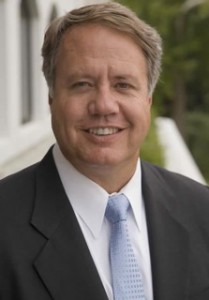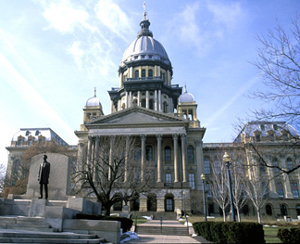Illinois Correspondent
Springfield, Ill. – It’s hard to imagine how the proud and prosperous prairie state of Illinois could have turned itself into one of the nation’s financial basket cases, but there’s no getting around it.
And it’s all for one main reason – a succession of governors and legislatures have failed for decades to properly fund pensions for state workers, leaving a potential liability of $98 billion. That’s billions – with a ‘B’ – and not millions.
The problem stretches back through the administrations of governors both Democratic and Republican, all of whom have eased budget difficulties by underfunding the public employee pensions. Quinn is the first governor to make full payments, but they are nowhere near enough to make up the gap.
After years of underpayments, a deal in 1994-95 under Gov. Jim Edgar was supposed to solve the problem with increased payments, but the money never materialized, and the deferrals continued right through the Blagojevich administration.
Education funding is being cut back by $400 million, prisons are being closed, mental health care is being reduced, and a host of other state responsibilities are going unfunded.
It’s just like the guy with a self-funded retirement who never gets around to saving any money. When retirement hits, he’s still got costs and responsibilities but no way to pay for them.
Legislators and state employees have no problem agreeing that something needs to be done, but the hard part is determining what to do.
LABOR AS PART OF THE SOLUTION

“They’ve got to work something out,” says Dale Stewart, executive secretary-treasurer of the Southwestern Illinois Building and Trades Council. “It might have helped if they had brought labor in earlier.”
Gov. Pat Quinn, in a speech to the Legislature earlier this month, called on the legislature to work out some solutions. “This is the most difficult budget Illinois has ever faced, and it is only a preview of the pain that is to come if this General Assembly does not act decisively on comprehensive pension reform,” he said.
Several bills have been working their way through the House and the Senate, some of them comprehensive plans, but some just nips and tucks for individual cuts or revisions that might ease the problem but won’t solve it on their own. It’s not clear yet what legislation might actually emerge.
One of the most prominent proposals is called “We Are One,” developed by a coalition of labor groups and legislators. In it, workers would make the first sacrifice by paying an additional 2 percent of their wages into their share of their pensions, which would generate about $10 billion over 30 years.
In addition, the bill calls for revenue that becomes available as old bond issues and debts are paid off to be devoted to the pensions, and it would guarantee that the state would, from now on, pay in the amount it was supposed to have been paying each year. The coalition has also called for closing business tax loopholes to generate an estimated $2 billion a year for pension revenue.

Rep. Jay Hoffman, D-Belleville, chairman of the House Labor and Commerce Committee, is a sponsor of that legislation. He notes that it attacks the problem without requiring cuts to the benefits that have already been promised to workers.
“They paid their required amount, but the state didn’t,” he told the Labor Tribune. “To diminish their benefits now is probably unconstitutional. A promise was made and should be kept.”
PROPOSED CUTS TO BENEFITS
Other players believe the problem cannot be solved without cuts to benefits, but any such plan is considered likely to wind up going before the state supreme court. “We have to find the solution within the confines of the Illinois constitution,” Hoffman said.
Recently, the House Personnel and Pensions Committee voted 9-1 to approve House Bill 3411, described as a comprehensive and bipartisan bill. It has the 2 percent worker contribution increase and required state pension payments, but it goes on to trim benefits, such as limiting cost-of-living raises (COLA) to the first $25,000 in pensions and delaying COLA start times. Finally, it would create a new plan for workers who joined the system this year that would incorporate a 401(k)-style investment plan.
Supporters say the combined effects would cut about $29 billion out of the pension debt and decrease the pension payment growth that is crowding the rest of the budget. It is sponsored by Rep. Elaine Nekritz, D-Northbrook, who has become a leader on the issue, and the House Minority Leader, Rep. Tom Cross, R-Oswego.
NEGOTIATIONS WITH STATE WORKERS
Opponents, including We Are One coalition lawyer John Stevens, say the bill’s benefit cuts will not pass the constitutionality test, so the issue could yet wind up in court. Stevens recommends negotiations with the state workers’ unions to find a compromise.
Meanwhile, the Senate passed SB 1, which would require teachers to choose between annual pension increases or health insurance subsidies. Senate President John Cullerton (D-Chicago said it will be the first of several individual pension bills the Senate will consider.
Some legislators say it will ultimately be up to House Speaker Michael Madigan to weave together the individual strands of legislation into a cohesive whole. The process they are going through now is seen as a way of weeding out proposals that won’t fly, such as one voted-down plan to increase workers’ contributions by 4 percent instead of 2 percent. Other possibilities include tinkering with the retirement age or the maximum salary used as a basis for pensions, or shifting some costs to hard-up local governments and school districts.
In his speech, Quinn said the pension funding is only about 39 percent of where it should be when at least 80 percent is needed.
Said Quinn: “This is a choice about whether we will make the tough decisions necessary to balance our budget by reforming our public pensions systems, or whether we will let our jobs, our safety and our schools be squeezed out by skyrocketing pension costs.”


